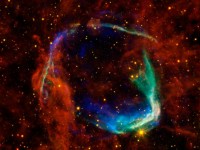"Cosmic GDP" crashes 97% as star formation slumps

While parts of the world experience economic hardship, a team of astronomers co-led by Professsor Philip Best at the Institute for Astronomy in Edinburgh has found an even bigger slump happening on a cosmic scale.
In the largest ever study of its kind, the international team has established that the rate of formation of new stars in the Universe is now only 1/30th of its peak and that this decline is only set to continue. The results were published today in the journal Monthly Notices of the Royal Astronomical Society.
Recycling stars
The accepted model for the evolution of the Universe suggests that stars began to form about 13.4 billion years ago, or around three hundred million years after the Big Bang. Many of these first stars are thought to have been monsters by today's standards, and were probably hundreds of times more massive than our Sun. Such beasts aged very quickly, exhausted their fuel, and exploded as supernovae within a million years or so. Lower mass stars in contrast have much longer lives and last for billions of years.
Much of the dust and gas from stellar explosions was (and is still) recycled to form newer and newer generations of stars. Our Sun, for example, is thought to be a third generation star, and has a very typical mass by today's standards. But regardless of their mass and properties, stars are key ingredients of galaxies like our own Milky Way. Unveiling the history of star formation across cosmic time is fundamental to understanding how galaxies form and evolve.
In the new study, the scientists used the UK Infrared Telescope (UKIRT), the Very Large Telescope (VLT) and the Subaru telescope to carry out the most complete survey ever made of star-forming galaxies at different distances, with around ten times the data of any previous effort. With the range of distances, the time taken for the light to reach us means that we see identically-selected galaxies at different periods in the history of the universe, so we can really understand how conditions change over time.
"You might say that the Universe has been suffering from a long, serious 'crisis': cosmic GDP output is now only 3% of what it used to be at the peak in star production! The future may seem rather dark, but we're actually quite lucky to be living in a healthy, star-forming galaxy which is going to be a strong contributor to the new stars that will form." David Sobral, former PhD student at the Institute for Astronomy, who led the paper.
By looking at the light from clouds of gas and dust in these galaxies where stars are forming, the team were able to assess the rate at which stars are being born. They find that the production of stars in the Universe as a whole has been continuously declining over the last 11 billion years. Half of the stars in the Universe were born in the 'boom' that took place between 11 and 9 billion years ago and it took more than five times as long to produce the rest. If the measured decline continues, then no more than 5% more stars will form over the remaining history of the cosmos, even if we wait forever.
Professor Best added "While these measurements provide a sharp picture of the decline of star-formation in the Universe, they also provide ideal samples to unveil the even more fundamental mystery which we are continuing to work to solve: why?"

